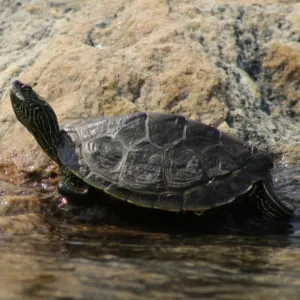There are 11 species of turtles in Wisconsin, ranging from the more terrestrial Ornate Box turtle to the fully aquatic Common Snapping turtle. Some of Wisconsin’s native species are unfortunately endangered or threatened, such as the Wood turtle.
Efforts by the Wisconsin Department of Natural Resources aim to monitor and protect these vulnerable turtle populations, particularly focusing on conserving their nesting sites.
Throughout this list we’ll explore each of Wisconsin’s native turtle species. This list can be used as a field herping guide or as a way of choosing your next pet turtle. Keep in mind that it may be illegal to possess some of these species in Wisconsin, so it’s always best to research state laws regarding turtle ownership.
Clicking on the name of each turtle will take you to a comprehensive care guide that will help you prepare for owning one of these turtles. After you’ve decided on the species you’d like to get, try and adopt one from an animal shelter first.
If this isn’t possible, then it’s best to purchase a captive-bred specimen from a registered breeder rather than taking a turtle from the wild. It is illegal to take some species of turtle in Wisconsin, so make sure to familiarize yourself with the rules and regulations.
Now, without further ado, let’s dive into the 11 species of turtles in Wisconsin.
Turtles in Wisconsin
1. Blanding’s Turtle

- Experience Level: Intermediate
- Family: Emydidae
- Scientific Name: Emydoidea blandingii
- Other Names: N/A
- Adult Size: 5 to 8 inches (12.5 to 20 cm)
- Lifespan: Up to 80 years
- Average Price Range: $300 to $450
Blanding’s turtles are named after William Blanding, an 18th Century American naturalist. These long-lived semi-aquatic turtles have dark oval shells covered in yellow speckles, with yellow necks and plastrons that have black markings.
Although they are a species of Special Concern in Wisconsin, Blanding’s turtles can be found in many areas across the state. They inhabit marshes and other wetland habitats as well as meadows. They are cautious, often diving to safety at any sign of trouble.
During late May, the nesting season for Blanding’s turtle begins, often near water bodies with sandy soil which is ideal for their nest sites.
Blanding’s turtles are omnivorous and mainly eating crustaceans, insects, and mollusks such as earthworms. They will also occasionally eat plants.
2. Ornate Box Turtle
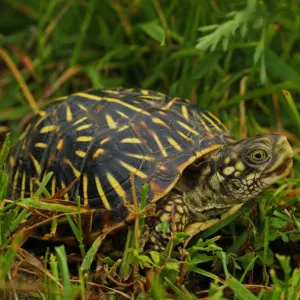
- Experience Level: Intermediate to Expert
- Family: Emydidae
- Scientific Name: Terrapine ornata
- Other Names: Box Tortoise, Western Box Turtle
- Adult Size: 4 to 5 inches (10 to 12.5 cm)
- Lifespan: 30 to 40 years
- Average Price Range: $130 to $450
Ornate Box turtles are a more terrestrial species that inhabits open regions such as grasslands, prairies, and woodland areas. This species is classed as Endangered in Wisconsin, and can only be encountered in some extreme southern counties.
Habitat fragmentation, particularly in southern Wisconsin, poses significant threats to their populations. The western subspecies of Ornate Box Turtle, however, is more adaptable to varying habitats.
Ornate Box turtles have distinctive orange to yellow striped patterns across their domed dark brown shells, except for the rim of the carapace which is plain. This diurnal species is more active after rainfall but is threatened by habitat loss and collection for the pet trade.
Ornate Box turtles are omnivorous, mainly eating insects, mollusks, and occasionally carrion. They will also eat vegetation such as berries or plants.
3. False Map Turtle

- Experience Level: Beginner
- Family: Emydidae
- Scientific Name: Graptemys pseudogeographica
- Other Names: Sawback turtle
- Adult Size: 3.5 to 10.5 inches (9 to 26.5 cm)
- Lifespan: 30 to 50 years
- Average Price Range: $6 to $40
False Map turtles, preferring sandy bottoms, thrive in Wisconsin’s main river systems, where they find suitable nesting areas. Although they have only been recently classified in Wisconsin, they are thought to be fairly common.
To distinguish themselves from other species of Map turtles, False turtles lack colored markings on their heads. They have dark brown or black shells with the typical contour-like yellow markings of Map turtles. Most adult specimens have a pronounced keel on their backs.
False Map turtles are omnivorous and eat aquatic insects, crustaceans, mollusks, and aquatic plants. They rarely travel far from the water and like to bask on outcrops above the surface.
4. Northern Map Turtle
- Experience Level: Beginner
- Family: Emydidae
- Scientific Name: Graptemys geographica
- Other Names: Common Map turtle
- Adult Size: 4 to 10.5 inches (10 to 26.5 cm)
- Lifespan: 15 to 20 years
- Average Price Range: $20 to $60
Northern Map turtles are an aquatic species commonly found in Wisconsin’s major river systems. These turtles are accomplished swimmers and like to bask above the surface of the water.
Northern Map turtles have dark brown or olive green shells with yellowish markings that resemble the contours of a map. Small yellow spots behind the eyes distinguish the Northern Map turtle from other subspecies.
These turtles are mainly carnivorous, feeding on aquatic insects, crustaceans, small fish, and mollusks. They may also eat plants occasionally.
5. Ouachita Map Turtle
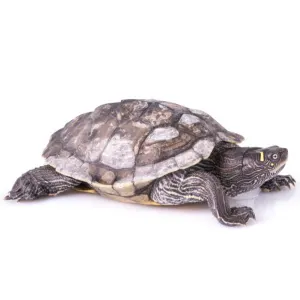
- Experience Level: Beginner
- Family: Emydidae
- Scientific Name: Graptemys ouachitensis
- Other Names: Southern Map turtle
- Adult Size: 3.5 to 10 inches (9 to 25.5 cm)
- Lifespan: 15 to 20 years
- Average Price Range: $40 to $100
Also known as Southern Map turtles, Ouachita Map turtles are relatively common in the rivers of Wisconsin’s southern and southwestern regions. They are active during the day and like to bask, but are easily startled and will quickly jump into the safety of the water.
Ouachita Map turtles can be distinguished from other Map turtles by the large lightly colored patches behind their eyes. These Map turtles also have dark patches outlined in yellow contour-like markings on the scutes of their dark or olive green shells. Males have a prominent serrated keel protruding from their backs.
As with many other turtles, Ouachita Map turtles are omnivores. They mainly eat crustaceans, insects, and mollusks. They will also occasionally eat algae and aquatic plants.
6. Eastern Musk Turtle
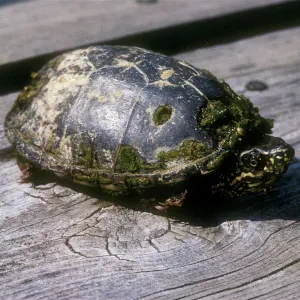
- Experience Level: Intermediate
- Family: Kinosternidae
- Scientific Name: Sternotherus odoratus
- Other Names: Common Musk turtle, Stinkpot
- Adult Size: 4 to 5 inches (10 to 12.5 cm)
- Lifespan: 50+ years
- Average Price Range: $20 to $90
Eastern Musk turtles are commonly known as “Stinkpots” because of the strong odor they can excrete from their musk glands to deter predators. Eastern Musk turtles are one of North America’s smallest aquatic freshwater turtles and can be found in southeastern parts of Wisconsin.
Eastern Musk turtles have dark brown or black unmarked shells. They have two yellow stripes running down their dark heads as well as fleshy barbels on their chins and necks. This species prefers slow-moving waters in boggy or marshy areas with dense fronds of aquatic vegetation.
These nocturnal omnivores mainly eat small amphibians, crustaceans, and mollusks. They are considered common in Wisconsin.
7. Painted Turtles
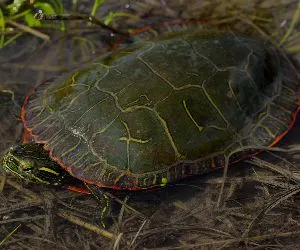
- Experience Level: Beginner
- Family: Emydidae
- Scientific Name: Chrysemys picta marginata (Midland Painted), Chrysemys picta belli (Western Painted)
- Other Names: N/A
- Adult Size: 4 to 10 inches (10 to 25.5 cm)
- Lifespan: 30 to 50 years
- Average Price Range: $20 to $50
There are two subspecies of Painted turtles found in Wisconsin; the Midland Painted turtle and the Western Painted turtle. These two species are some of the most common turtles in Wisconsin, with the Western Painted turtles inhabiting northwestern and western regions and Midland Painted turtles found in Wisconsin’s other areas.
Painted turtles have dark brown to black shells that usually have yellow to red coloration around the edge. Midland Painted turtles have plain yellow plastrons, while the slightly larger Western Painted turtles sport a series of green, brown, and blue markings on their red plastrons. Both species have brown skin with yellow stripe markings on their faces and necks.
These medium-sized aquatic turtles are diurnal and prefer shallow waters such as marshes and ponds and can often be seen basking on logs beside the water. Both subspecies in Wisconsin are omnivores, consuming small amphibians, insects, mollusks, and vegetation.
8. Common Snapping Turtle
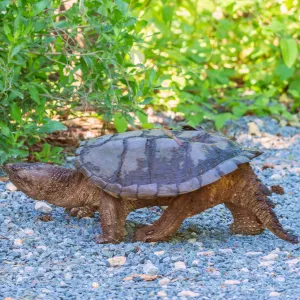
- Experience Level: Intermediate to Expert
- Family: Chelydridae
- Scientific Name: Chelydra serpentina
- Other Names: Common Snapper, Eastern Snapping turtle, Snapper
- Adult Size: 8 to 20 inches (20 to 51 cm)
- Lifespan: 30 to 50 years
- Average Price Range: $20 to $40
Common Snapping turtles are the largest species found in Wisconsin and are found in larger bodies of water across the state, such as lakes and reservoirs. Common Snappers are one of the biggest heavyweights in Wisconsin’s freshwater food chain.
Easily identified thanks to their powerful hooked jaws, Common Snappers have dark brown or green shells with ridges on the carapace. These large turtles have long saw-toothed tails and sharp claws. They are notable for their aggressive behavior and powerful jaws. The top shell, or carapace, of the Common Snapping Turtle is particularly rugged and large in size. If captured on land, this species can hiss aggressively and will attempt to bite.
Common Snapping turtles are nocturnal omnivores that consume amphibians, fish, smaller reptiles and turtles, and even waterfowl. They may also eat vegetation from time to time.
9. Smooth Softshell Turtle
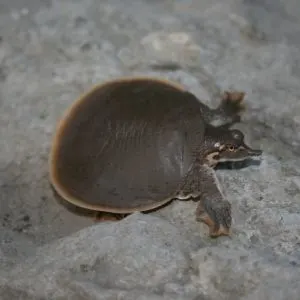
- Experience Level: Intermediate to Expert
- Family: Trionychidae
- Scientific Name: Apalone mutica
- Other Names: Spineless Softshell
- Adult Size: 4.5 to 14 inches (11.5 to 35.5 cm)
- Lifespan: 25+ years
- Average Price Range: $40 to $60
Smooth Softshells are a medium to large species of aquatic turtle that has Special Concern status in Wisconsin. Smooth Softshells are currently found in just a few scattered southwestern counties, where they inhabit rivers with sandy or silty bottoms.
Andrew Badje, a conservation biologist, notes that the female turtle’s preference for sandy soil makes nesting challenging in altered habitats.
Smooth Softshells resemble leathery pancakes with cream to white plastrons. Their shells are usually brown or gray, and they have distinctive lines running from behind their eyes. Smooth Softshells have tapered snouts which they use as snorkels while waiting to catch prey.
These aquatic turtles usually bury themselves in shallow sands to ambush aquatic insects, crustaceans, and mollusks. Due to the habitat loss of areas with nesting sandbars, Smooth Softshells are in a vulnerable position.
10. Spiny Softshell Turtle
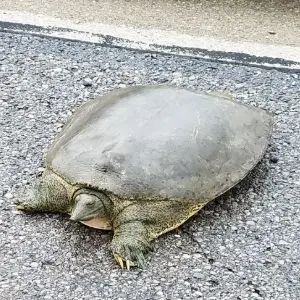
- Experience Level: Intermediate to Expert
- Family: Trionychidae
- Scientific Name: Apalone spinifera
- Other Names: N/A
- Adult Size: 5 to 17 inches (12.5 to 43 cm)
- Lifespan: 20 to 50 years
- Average Price Range: $70 to $280
Spiny Softshells are the most commonly encountered type of Softshell in the Badger state and can be found across most of the state. They prefer rivers and streams with a faster-moving current and are skilled swimmers.
Spiny Softshells have a leathery pancake-shaped green shells that feel a bit like sandpaper and sport a series of spines along the front edge. They also have dark spot markings on their soft carapaces. They have long, tapered beaks which they use to breathe while buried in the sand waiting to ambush their prey.
These Softshells are carnivores and will feed on any crustaceans, insects, and mollusks that swim past their hiding place. They then lunge forward and grab the prey in their mouths.
11. Wood Turtle

- Experience Level: Intermediate
- Family: Emydidae
- Scientific Name: Glyptemys insculpta
- Other Names: N/A
- Adult Size: 5.5 to 8 inches (14 to 20 cm)
- Lifespan: 40 to 60 years
- Average Price Range: $250 to $500
Wood turtles are an intelligent, largely terrestrial species that inhabits grasslands and woodland areas close to rivers and streams. This species is Threatened in Wisconsin due to habitat loss. Conservation efforts in the state, involve using radio transmitters to track Wood Turtles’ movements and understand their habitat use better. That said, they have been recorded as being seen in most areas of the state.
Wood turtles get their name from their dark brown shells, which have a rough, grainy texture and scutes that look as if they have been sculpted from wood. These turtles have markings that appear similar to the growth rings and wood grain of trees.
These diurnal omnivores roam a fair distance each day while looking for berries, earthworms, insects, mollusks, and plants to eat.
Frequently Asked Questions about Wisconsin’s turtles
What kind of turtles live in Wisconsin?
Wisconsin is home to 11 species of freshwater turtles, ranging from small aquatic species such as Eastern Musk turtles to larger specimens such as Common Snappers. Most of Wisconsin’s turtles are fairly common, although some species like the Ornate Box turtle and the Wood turtle are classed as Endangered or Threatened.
Where do Box turtles live in Wisconsin?
Ornate Box turtles are the only type of Box turtle native to Wisconsin. These endangered terrestrial turtles inhabit grasslands, prairies, and woodland regions in only a few of Wisconsin’s extreme southern counties;
- Columbia County
- Dane County
- Grant County
- Green County
- Iowa County
- Rock County
- Sauk County
Do Snapping turtles live in Wisconsin?
Common Snapping turtles are Wisconsin’s only native Snapping turtles and are the state’s largest species. These freshwater turtles can be found in larger bodies of water throughout the entire state and are fully aquatic. They will hiss and bite if captured.
Are Painted turtles native to Wisconsin?
There are two subspecies of Painted turtles that are native to Wisconsin; Midland Painted turtles (Chrysemys picta marginata) and Western Painted turtles (Chrysemys picta belli). Painted turtles are one of Wisconsin’s most commonly encountered species and can be found across the state, with Western Painted turtles sighted in northwestern and western counties and Midland Painted turtles in other areas.
Is it illegal to collect turtles in Wisconsin?
Wisconsin has specific laws in place regarding the capture of native turtle species. Capturing Federal or State protected species is illegal. This means that Blanding’s turtles, Ornate Box turtles, and Wood turtles cannot be taken from the wild.
Any other aquatic turtles can be taken in Wisconsin if you possess a Fishing or Small Game license. The season for capturing aquatic turtles extends from mid-July to the end of November. Possession limits are in place. You can take 5 specimens of each species except for Spiny Softshells (Apalone spinifera). You can only take 3 Spiny Softshells.
As for owning native Wisconsin turtles as pets, the State-protected turtles mentioned above cannot be kept, nor can any Federally protected species. For the remaining species, a possession limit of 5 individuals of each species is in place (3 for Spiny Softshells).
See our turtle laws page for more information.
Are Snapping turtles protected in Wisconsin?
Common Snapping turtles are not protected in Wisconsin and can be taken from the wild. However, there are restrictions and limits regarding their capture.
No more than 5 Common Snappers can be taken per season (mid-July to end of November), although if fishing on the sections of the Mississippi River that run through Wisconsin, you can take 10 specimens. You must have a Fishing or Small Game license to collect Common Snappers.
A size restriction is also in place for the capture of Common Snappers. You can only take wild Common Snappers that have shells measuring from 12 inches (30.5 cm) to 16 inches (40.5 cm).
What are the biggest turtles in Wisconsin?
The biggest species of turtle found in Wisconsin is the Common Snapping turtle (Chelydra serpentina), which can reach lengths of up to 20 inches (51 cm). The next biggest species in Wisconsin is the Spring Softshell (Apalone spinifera) which can grow up to 17 inches (43 cm).
Conclusion
It’s important to understand the human impacts on turtle populations in Wisconsin. Conservationists emphasize the need for cooler temperatures during the active season to ensure turtle eggs hatch the following spring. From the long-necked Western Box Turtles to rare species with a low dorsal keel, each plays an important role in Wisconsin’s ecosystems.
Well, that’s the end of our list of the 11 native turtles in Wisconsin. We’ve talked about several turtles in this list, ranging from terrestrial species such as the endangered Ornate Box turtle to commonly encountered aquatic species like the Common Snapper or Painted turtle.
This list is best used as a field herping guide to help you identify native turtles when out hiking or exploring. You can also use this list to help choose your next pet turtle, and clicking on the name or image of each species will take you to a dedicated care guide.
We hope you enjoyed this list! If you did, don’t hesitate to comment down below and discuss Wisconsin’s native turtles with your fellow herp enthusiasts.
Other nearby states

